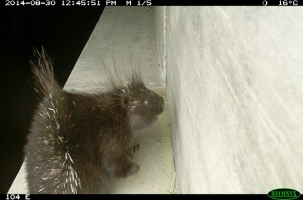Researchers: Michael J. Rolheiser and Jochen Jaeger
Project description:
Wildlife-vehicle collisions result in the deaths of hundreds of millions of vertebrates globally, a dire impact of roads on wildlife populations. In efforts to identify stretches of high or low mortality, hotspots and coldspots can be identified by using GPS coordinates of carcass locations. If animals move through some parts of a landscape more frequently than others, the hotspots and coldspots of adjacent highways are expected to align to some degree. In summer 2021, we carried out road mortality surveys along two parallel highways in southern Québec (Autoroute 10 and Route 112), detecting 2932 carcasses among 67 species or species groups, ranging in body size from eastern newt (Notophthalmus viridescens viridescens) to white-tailed deer (Odocoileus virginianus). We identified hotspots and coldspots at three scales (50 m, 100 m, and 500 m radius) using Siriema, a spatial analysis software, to compare their locations, patterns, sizes, and strengths between the two highways. The degree of alignment of hotspots and coldspots between both highways differed by animal type. Amphibians and reptiles displayed consistent alignment, whereas birds and mammals did not. The results suggest a stronger association among amphibians and reptiles to specific landscape variables, such as wetlands, while birds and mammals do not share a similarly strong association because the landscape does not change drastically. Implication from this research include the need for hotspot and coldspot analysis along entire road networks and the need to coordinate mitigation efforts (such as wildlife passages and fencing) to consider the spatial relatedness of hotspots and coldspots between adjacent roads. Mitigation measures installed at one road should be coordinated with the location of mitigation measures implemented at other roads, i.e., a landscape-scale mitigation approach is needed that considers the alignment between wildlife passages and wildlife-movement corridors.
Funding:
This project is funded by the Environment and Climate Change Canada.


